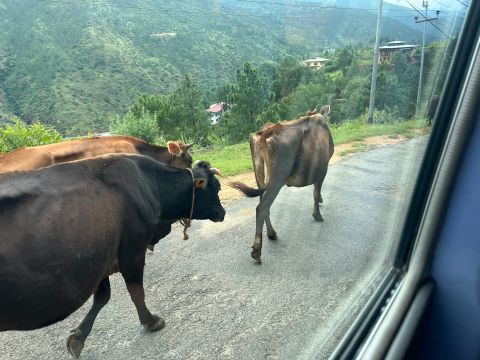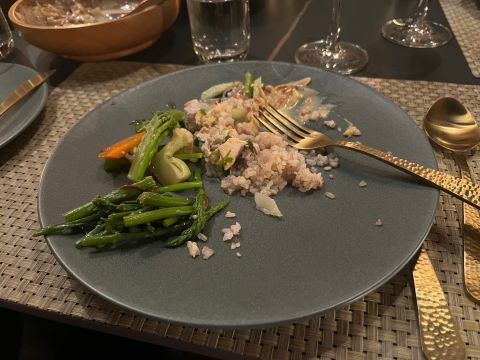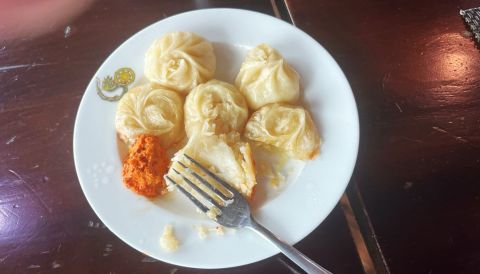What do they eat in the famously happy Himalayan kingdom? See also Bhutan - now a wine producer.
As I sat down to write this article, I realised the enormity of the challenge.
I was in Bhutan for a week, a country I had dreamed of visiting for most of my life. Yet other than its high mountains, the ubiquity of green in every direction, and the country’s devotion to Buddhism and therefore the popularity of vegetarianism, I knew very little about the material conditions that shape its food culture.
The religious approach to cooking – maintaining the sanctity of life as paramount – has, incidentally, several unforeseen consequences. It meant, for example, that our coach driver had to be as adept at the steep turns as he was at avoiding the cattle allowed to wander freely on all roads. If a cow seriously blocked our way, a deep, guttural grunt from him seemed to do the trick eventually. Other animals we encountered included donkeys, horses and the occasional monkey, including some ‘lucky’ white monkeys.
I was also aware that Bhutan is landlocked and stands proudly, if slightly anxiously, between extremely populous India to the south and China to the north. Fish and seafood are therefore in short supply although I noted a salmon dish on the menu on our first night, at the Zhiwaling Heritage, a hotel in a beautiful gorge just outside the small town of Paro, location of the country’s only international airport.
But it took a Bhutanese woman to explain the country’s seeming indifference to desserts, a phenomenon that did nothing to help me when sleep seemed impossible due to jet lag. ‘It’s because there is no sugar planted anywhere in our country’, my acquaintance politely explained, ‘so we have no tradition of providing sweet things at the end of the meal’.
But there were many compensations. Firstly, in momos, the spherical dumplings that are as popular here as they are in Tibet (see my review of this Tibetan restaurant in Oxford). Momos from central Bhutan are slightly different, made from buckwheat, sometimes fried, and called hoentay.
Then there is the chilli accompaniment, either a paste or a relish, which may vary in strength but never fails to appear as a condiment. Even on top of a pizza. At the Mountain Cafe in Paro, a surprisingly delicious cheese pizza arrived with a small bowl of chilli paste on the top. In Bhutan chilli is as commonplace as the smile on the face of whoever is serving you.
Although Bhutan has modernised itself considerably over the past 40 years, none of the cafes or restaurants I visited boasted anything as modern as an open kitchen. When I enquired as to the gender of those working in the kitchens I was told that in general it was 50:50 but that it had been female chefs who cooked our exceptionally delicious lunch in the Hotel Phuensum in Bajo near Punakha one rainy lunchtime. We enjoyed dhal soup, two lots of rice, egg noodles with vegetables, a pea curry, a thick cheese and chilli soup, light dosas stuffed with vegetables to be eaten like spring rolls, and an enormous plate of sliced cucumber, carrots, limes for squeezing and whole chilis which our Bhutanese host showed us how to eat. ‘Take a chilli, dip it in salt and eat it with a slice of onion’, he explained with a smile. Not one of us followed his example.
Dinner on our second night in the Zhiwaling hotel had revealed a great deal about the country and its food. We were a party of 10 and had specifically requested a Bhutanese meal rather than the more international choices offered on the first night. The kitchen offers a wide range of traditional dishes for US$78 per person (and a shorter, similar menu for $30 less). Beforehand we were entertained for an hour outside by a display of Bhutanese music and dance – the performers are shown at the top of this article – against a background of thunder, lightning and the odd raindrop.
We began with a soup, river-weed egg-drop soup, whose origins apparently lie with the weeds picked from the bed of one of Bhutan’s many (very clean) rivers. (These weeds are sold in the country’s many food markets.) This was excellent with a vegetable dumpling as a bonus. Soups are common, especially the so-called ‘butter tea’, prepared with salt and butter, which we were served from a big silver teapot on two or three occasions and is apparently a cure for chapped lips, a common phenomenon at high elevations.
There then followed a series of dishes which we were to see repeated during the week. There is always a large bowl of red rice, a Bhutanese speciality. A salad, goen hogay, of cucumber, tomato, onion, coriander, cottage cheese and Sichuan pepper, was also quite common, as was a thicker potato and cheese curry, and a seemingly innocuous dish of cottage cheese, local butter and chilli flakes that was actually extremely spicy.
Then, relatively unusually and perhaps aimed at tourists, came two meat dishes: braised chicken in an onion and tomato gravy with coriander that was fairly mild, and a dish described as Bhutanese-style braised beef – with dried red chilli of course. The emphasis here should be on the words ‘Bhutanese style’, which in the case of meat and cheese is to allow the produce to dry out until it is rock hard and then to chew on it for ages. Many a roadside stall belonging to those who also tend the cows were adorned with strings of rock-hard cheese lozenges. Of several fine vegetable dishes, the thin, succulent strands of butter-fried local asparagus stood out.
Dessert, a jelly based on red rice with a minted fruit salad, was disappointing. But as it is an aspect of a meal that many tourists will expect, it is something that the Bhutanese might consider addressing. They have the fruit, honey, plenty of ginger and no shortage of dairy produce.
But what was truly memorable about our few days eating in Bhutan was the juxtaposition of quintessentially Bhutanese dishes with truly unforgettable locations.
There was the plate of cheese momos (above) that I ordered in the Dochula cafe as the road crested the Black Mountains between the capital Thimphu and Punakha. From here, when there is no mist, it is apparently possible to see seven Himalayan mountain peaks, each over 21,000 ft (6,400 m).
Then there was the picnic lunch, with the inevitable chilli paste, on the bank of the fast-flowing Punatsangchhu river downstream of the complex engineering works required to supply India to the south with hydroelectric power. With a range of powerful rivers flowing south, Bhutan has an oversupply of both water and energy.
And finally there was the walk to the Happiness Field Village Farmstay for a lunch on a farm which included a powerful dish of wild boar braised with spinach and chilli. But equally memorable was the walk there and back, half of it on a narrow suspension footbridge in a strong wind swaying less than thirty feet above an extremely fast-flowing river.
Only in Bhutan.
Every Sunday, Nick writes about restaurants. To stay abreast of his reviews, sign up for our weekly newsletter.








